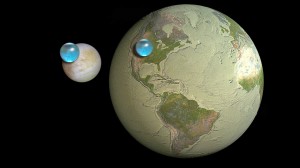Microplastics are just what the name implies….tiny bits of plastic from a myriad of sources, like washing fleece material in a washing machine for example. It’s been described as a problem affecting the food chain in oceans, but guess what? Around 90 percent of table salt brands were found to contain these (since I had of our salt comes from the ocean). So, we’re all ingesting these, not just marine life. Unfortunately, no one’s really sure what health risks, of any, this poses. Read this article for more on this:
Using graphene to filter and desalinate saltwater
As the global population increases and water supplies become less predictable due to global warming, finding sources of clean drinking water becomes even more critical. Just ask residents of Cape Town, which expects to run out of water around April 12nd! The obvious solution is to desalinate ocean water, but that’s a very energy-intensive process. Well, researchers in Australia found a way to use a graphene film to act as a filter; its structure allows water molecules to pass through but blocks larger contaminant particles. Most membrane filters get clogged up quickly, but this one keeps working even as it gets coated in contaminants. It’s nowhere near a commercial product yet, but is a promising solution to a growing global concern.
(more at FastCompany)
How much water IS there on Earth?
 This is really cool…the image here shows how much water there is on Earth, if you were to gather it all up in a ball and compare it to the size of the whole planet. It really puts things in perspective, doesn’t it?
This is really cool…the image here shows how much water there is on Earth, if you were to gather it all up in a ball and compare it to the size of the whole planet. It really puts things in perspective, doesn’t it?
(via io9)
Now, take this a step further, and think about the water on this planet compared to others in our solar system. Our little blue marble in space seems to be the gem, the most water-rich planet orbiting this star. Well, it turns out that’s not exactly true, if you count moons at least. Check out the picture below, showing the water on Earth, compared to the estimated water on the moon Europa! In terms of volume, Europa is estimated to have two to three times the volume of water that Earth does. Incredible!
(via io9)
Peak Water – aquifer depletion
Not exactly news, but some more warning signs about depletion of underground water supplies in this article at Scientific American. The basic problem is that agricultural demands are depleting the aquifers and eventually we won’t be able to rely on them for food production. The good news is that around 80% of the world’s aquifers are being managed sustainably, but that 20% that’s not are critical to food production. Combine that with global warming and an increasing planetary population, and it seems we have a serious problem looming.
One other bit of bad news…it apparently takes around 140 liters of water to grow the beans for a single cup of coffee! Crops like that, which can be considered ‘luxury’ crops, will soon be forced aside to make room for the staples we need to survive. Not quite time to sell your Starbucks stock perhaps, but I wouldn’t consider that a good long term investment…
Threatened water supply
There are a couple interesting threats to the security of our future water supply. The first involves depletion of groundwater for agricultural uses. Already, we’re using it at an unsustainable rate, and the future viability of irrigated agriculture is, at this point, somewhat uncertain in some areas. However, as this article points out, there’s more that can be done using existing technology to decrease water usage, like more efficient watering methods (drip irrigation, for example) and construction of more water storage systems. That takes money though, either with higher food prices, and/or government infrastructure investment. In the current political and economic climate, the later is unlikely, so expect higher food prices to hit first before public pressure creates the political will to improve the infrastructure.
The second development that is going to place increasing demands on our water supply is electricity, strangely enough. As this article explains, most modern power plants require large amounts of water in order to cool them. Well, the power plants that aren’t using renewable energy like solar or wind, that is.
Then of course, there’s fracking, which not only pollutes the groundwater, but uses a lot of water as a primary ingredient in the fracturing fluid that’s pumped underground. Sort of a double-whammy there.
So what does this all mean? It means that like many other things, we’re nearing Peak Water, where the supply of water will be less than the demand. Or rather, the supply of clean, drinkable water. We’ll likely be forced to turn to more expensive filtering methods to increase the drinking water supply, and for coastal communities, it’s hard to imagine a world without desalination being key. Costs will increase.

